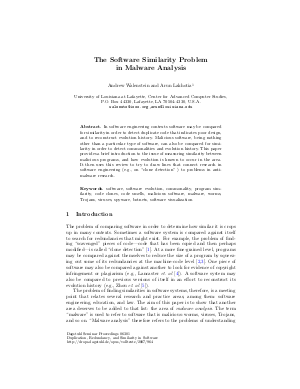The Software Similarity Problem in Malware Analysis
Authors Andrew Walenstein, Arun Lakhotia
-
Part of:
Volume:
Dagstuhl Seminar Proceedings, Volume 6301
Part of: Series: Dagstuhl Seminar Proceedings (DagSemProc) - License:
 Creative Commons Attribution 4.0 International license
Creative Commons Attribution 4.0 International license
- Publication Date: 2007-04-19
File

PDF
DagSemProc.06301.14.pdf
- Filesize: 183 kB
- 10 pages
Document Identifiers
Subject Classification
Keywords
- Software
- software evolution
- commonality
- program similarity
- code clones
- code smells
- malicious software
- malware
- worms
- Trojans
- viruses
- spyware
Metrics
- Access Statistics
-
Total Accesses (updated on a weekly basis)
0Document
0Metadata
Abstract
In software engineering contexts software may be compared for similarity in order to detect duplicate code that indicates poor design, and to reconstruct evolution history. Malicious software, being nothing other than a particular type of software, can also be compared for similarity in order to detect commonalities and evolution history. This paper provides a brief introduction to the issue of measuring similarity between malicious programs, and how evolution is known to occur in the area. It then uses this review to try to draw lines that connect research in software engineering (e.g., on "clone detection") to problems in anti-malware research.
Cite As Get BibTex
Andrew Walenstein and Arun Lakhotia. The Software Similarity Problem in Malware Analysis. In Duplication, Redundancy, and Similarity in Software. Dagstuhl Seminar Proceedings, Volume 6301, pp. 1-10, Schloss Dagstuhl – Leibniz-Zentrum für Informatik (2007)
https://doi.org/10.4230/DagSemProc.06301.14
BibTex
@InProceedings{walenstein_et_al:DagSemProc.06301.14,
author = {Walenstein, Andrew and Lakhotia, Arun},
title = {{The Software Similarity Problem in Malware Analysis}},
booktitle = {Duplication, Redundancy, and Similarity in Software},
pages = {1--10},
series = {Dagstuhl Seminar Proceedings (DagSemProc)},
ISSN = {1862-4405},
year = {2007},
volume = {6301},
editor = {Rainer Koschke and Ettore Merlo and Andrew Walenstein},
publisher = {Schloss Dagstuhl -- Leibniz-Zentrum f{\"u}r Informatik},
address = {Dagstuhl, Germany},
URL = {https://drops.dagstuhl.de/entities/document/10.4230/DagSemProc.06301.14},
URN = {urn:nbn:de:0030-drops-9640},
doi = {10.4230/DagSemProc.06301.14},
annote = {Keywords: Software, software evolution, commonality, program similarity, code clones, code smells, malicious software, malware, worms, Trojans, viruses, spyware}
}
